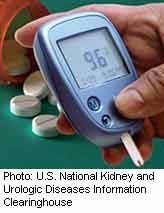
FRIDAY, Oct. 22 (HealthDay News) — The number of American adults with diabetes could double or triple by 2050 if current trends continue, warns a federal government study released Friday.
The number of new diabetes cases a year will increase from 8 per 1,000 in 2008 to 15 per 1,000 in 2050, predicts the U.S. Centers for Disease Control and Prevention. By 2050, between one-fifth and one-third of all adults could have diabetes — with virtually all the increase attributed to type 2 diabetes, which is largely preventable.
An aging population, an increase in minority groups at higher risk for diabetes, and the fact that diabetes patients are living longer are among the reasons for the steep projected rise.
“These are alarming numbers that show how critical it is to change the course of type 2 diabetes,” Ann Albright, director of CDC’s Division of Diabetes Translation, said in an agency news release. “Successful programs to improve lifestyle choices on healthy eating and physical activity must be made more widely available, because the stakes are too high and the personal toll too devastating to fail.”
Another expert agreed.
“These data are accurate and reflect reality,” said Dr. Mary Ann Banerji, professor of medicine and director of the Diabetes Treatment Center at SUNY Downstate Medical Center, New York City. “Taking into consideration minorities and longer life expectancy, the real burden of diabetes is much greater than many people thought.”
Banerji believes that “we need to act now. Immediate changes in diet, physical activity, stress and sleep are known to decrease diabetes and obesity. We can make changes in our physical environment to promote greater physical activity and we should consider changes in national food policy.”
Diabetes remains the leading cause of new cases of blindness under age 75, kidney failure, and preventable leg and foot amputation among adults in the United States, according to the CDC.
In addition, people diagnosed with diabetes have medical costs that are more than twice that of those without the disease, the agency reports. The total costs of diabetes in the United States are an estimated $174 billion annually, including $116 billion in direct medical costs.
The study appears in the journal Population Health Metrics.
The projected increase in U.S. diabetes numbers reflects the global growth of the disease. About 285 million people worldwide had diabetes in 2010, and the number could swell to as many as 438 million by 2030, according to the International Diabetes Federation.
About 24 million Americans have diabetes, but one-quarter of them don’t know it. Older age, obesity, a sedentary lifestyle, family history, developing diabetes while pregnant, and race/ethnicity are risk factors for type 2 diabetes. Racial/ethnic groups at increased risk are African Americans, Hispanics, American Indians/Alaska Natives, and some Asian-Americans and Pacific Islanders.
“The incidence of diabetes over the last few decades has progressively increased,” notes diabetes expert Dr. Jacob Warman, chief of endocrinology at The Brooklyn Hospital Center, New York City. “It is not surprising that with a flourishing of fast food chains and use of Internet and cable television, the population has become more sedentary and overweight.”
However, regular physical activity and proper nutrition can reduce the risk of type 2 diabetes and help control the disease. To that end, the CDC has launched a campaign to reduce such risks in overweight and obese people, stressing dietary changes, coping skills and group support to help participants lose 5 percent to 7 percent of their body weight and get at least 150 minutes per week of moderate physical activity.
Prevention programs that target at-risk groups can help reduce — but not eliminate — future increases in type 2 diabetes prevalence, the study said.
More information
The U.S. National Institute of Diabetes and Digestive and Kidney Diseases has more about diabetes.

